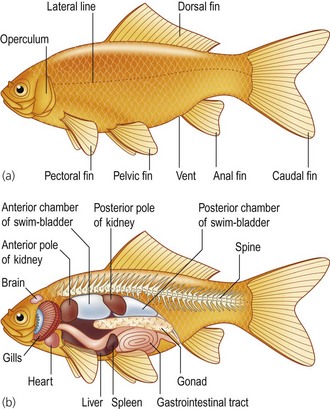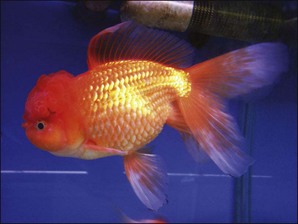25 Fish – an introduction
Taxonomy
There are two superclasses of fish. Although some aquarists keep cartilaginous fishes such as small sharks and rays, most fish species kept as pets belong to the last class in Table 25.1, the ray-finned fishes (Actinopterygii). This group includes (among many others) carps, flatfishes, perch-like fishes and seahorses.
Biology
Most fish species have protective scales covered by a layer of mucus; damage to these leads to problems with osmotic balance. The main site for gaseous exchange is the gills; these are also involved in osmoregulation and excretion of nitrogenous waste. These delicate organs are often the site of pathology. Internal organs are similar to mammals, although there are no lungs or diaphragm, and the kidneys lie dorsally just beneath the spine. Some species have a swim-bladder to assist with buoyancy. Fish are poikilothermic, and thus water temperature is important for immune function and metabolism of drugs (Fig. 25.1).

Figure 25.1 (a,b) External and internal anatomy of a fish, typified by the koi carp (Cyprinus carpio).
Goldfish (Carassius auratus)
Free-ranging goldfish originate from China (Fig. 25.2). They grow up to 25 cm in length. Captive breeding has produced many variations in colour, finnage and body form. This is a coldwater species (10–20°C), requiring a water pH of 6.5–7.5 and dH (hardness) to 15°. They produce a large amount of waste, necessitating efficient filtration and regular water changes (25% weekly). As with most fish, they are omnivorous; captive animals are usually fed on flake or pellet foods, but may also take vegetable matter and invertebrates. Eggs, when produced, are scattered in the tank.
History
The environment of the fish is important in maintenance of health (Box 25.1). The veterinary clinician should obtain details of the aquarium or pond set-up, including monitoring protocols and records employed by the aquarist. For large or complicated enclosures, it is often easier to visit the owner’s home to assess husbandry conditions visually.





